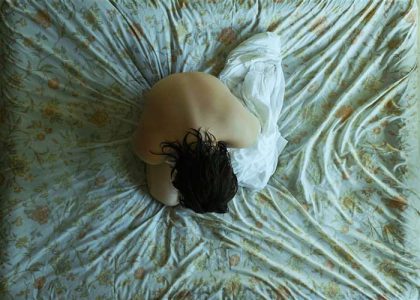
We continue our series on the 2020 Gold Medal Portfolio recipients with artist Ariana Diaz and writer Ayush Noori. Ariana used her photographic portfolio to document her personal experience with a permeating sense of sadness and melancholy. Following the death of his grandmother, Ayush wrote a chronicle of his grandmother’s life in order to confront feelings about mortality, fear, and pain.
Ariana Diaz
“The series Sinking developed from a personal place where I struggle with finding happiness…This body of work is based on the truthful documentation of myself in sadness, which is my habitual state of mind. Through using myself as a subject, it allowed me to be vulnerable…Because I am unable to feel, my entire existence depends on pursuing a solution for this problem.”

Ayush Noori
“In the ensuing essays, I release these caged stories, and in doing so, grapple with my own agony as I enter my first moments without my Nani by my side. By naming our fears and facing our pain, they cease to inhabit the realm of the unknown. For me, writing transcends the role of a simple therapeutic – rather, it is an intellectual and emotional celebration of my grandmother.”
Beyond Brains
Personal Essay & Memoir, Grade 12, Phillips Exeter Academy, Exeter, NH. The New York Times Writing Portfolio
This summer, I held a human brain in my hands and wondered which grieving grandson let the neuropathologist cleave it from his grandmother’s cold corpse. This 3-pound mass of dead, gray tissue was a relic of signals sent by synapses long-since strangled by the tangled proteins which invade the brain in Alzheimer’s. In our lab at MassGeneral Hospital, thanks to the generous sacrifice of dying patients, there is no shortage of severed brains – freezers full of frozen memories which I diced, sliced, and stained with esoteric antibodies, probing the diseased neurons and listening for their dying secrets. These are the processes – simple, sterile, and surgical – which, since antiquity, scientists have used to single out therapies, treatments, and cures. Scanning the cortical sections with fluorescent lasers, I converted webs of proteins, tendrils glowing in myriad colors, into echelons of ones and zeroes, black and white, clear digital code. This unique capacity to carve away the unknown and reveal the singular truth – intricate and interwoven, yes, but ultimately ordered and undeniable – secures my steadfast faith in modern medicine.
My grandmother’s neurons have been pillaged by the same proteins under my microscope. As neurodegeneration ransacked her memories, it also stole memories that should have been mine – my Nani and I belting happy birthday, baking cookies, or bursting into laughter as I barreled into her arms for a warm hug. The imagined echoes of these missing moments leave only surging anger in their wake. Instead, I curate an arsenal of prescription pills and prepare her favorite hot chocolate at 2AM, gently mopping her mouth with my sleeve as it dribbles down her chin.
My Nani is bound to a hospital bed, and I know that her cold, callous brain will soon be in the hands of someone like me, who will dice, slice, and stain. Modern medicine marches on, and martyrs like my grandmother surrender their cerebrums to our scalpels and scopes, so we may forge ahead, step by step, towards the cure. In some ways, this crusade brings me closure.
When your ringtone trumpets at 1:34am, it’s either a nervous beau, a scammer from India, or a harbinger of something much worse. That sultry July night, my inordinate optimism was no use when the attending pulmonologist at the Stanford Hospital intensive care unit declared that my grandmother would not survive the night. Her atelectatic lungs would inevitably collapse, the frail labyrinth of alveoli and bronchi flooded by viscid fluid. Within four hours, I left the research lab and boarded a flight to Palo Alto.
I have now deep sympathy for flailing fish, plucked from the ocean and suffocated by air in a genocidal massacre by merciless fisherman. If, like a fish, you gasped for oxygen at sixty breaths a minute, one mighty heave every second, how long would you last? Seven minutes? Two hours? Enough time for an airplane to traverse 3,107 miles? Flummoxing physicians and defying the conviction of countless specialists, my grandmother maintained a respiratory rate of 60 for nearly one week.
Each night, Nani played tug-of-war with death. As she slept, her retching lungs languished as the noose of mucus constricted in her chest. At ungodly hours, I wakened to code blues and prayed for miracles as platoons of medics, armed with IVs and resuscitators, forced air into her bleeding trachea. Conjuring lifeblood with each raspy cough, my grandmother repelled the impending last stand. This infernal ritual – our midnight tradition – continued unabated for nearly one week. When dawn kindled the firmament, we heralded her seeming resurrection, a lease of life until the next night.
In a desperate bid before their death, Chinook salmon rocket from the shackles of the river and soar upstream, braving the maw of grizzlies and smothering their gills for a transient moment of peace. Witnessing this annual spectacle helped me understand why, for perhaps the last time, Nani wanted to experience life beyond ambulances and without ICU wards. Once her condition stabilized, the stunned doctors hesitantly obliged. One week later, alone together at the summit of a rocky precipice on the California coast, Nani and I confronted the cold Pacific Ocean. It was risky – the shoreline was a warzone, a terrible collision between the firm, fertile earth and the swirling, murky water. Salvos of resentful swells beat the boulders, and churning currents of sand, silt, and salmon carcasses shot up the cliff face. It could not reach us. With each labored inhalation, sweet and clean breeze surged into Nani’s lungs, breathing blood into her fractured body, a bulwark against the rising tide. As tendrils of fog were born from the spray, the horizon melded with the gloomy mist until we opposed an infinite wall of gray. One could never be quite sure what lay beyond.
Mumbling with her mouth and signing with her stiff fingers, my grandmother asked me to return to my research. Above the clamor of the surf, she murmured into my strained ear, “Find me the cure.” Though silent she may be, you cannot quarrel with Nani. I was simply transferred to another front of the fight, where we use antibodies instead of Ambu bags, microscopes instead of moxifloxacin, lasers instead of levodopa. As the airplane ascended into the roiling clouds, I gazed down at the coast. My grandmother’s wheelchair is still perched on that cliff. Amidst this raging battle, this constant and ceaseless conflict, she stares at strange, beckoning forces past the gray horizon, shooting rays of God and brilliant flashes of green. She inches closer to the edge and gouges her heels into the ground.
I learned from my Nani that humans have dying secrets too, superpowers which we summon from spaces between our cells. She was determined to survive, to fight for the right to create more memories, to breathe, and banter, and bake, to celebrate my birthday with me. This determination, faith, and belief transcends the confines of modern medicine. I am comfortable with this contradiction. More than ever, I believe that medicine is our future. Yet, conclusions of clinicians cannot explain how a 3-pound lump of limp tissue, a jumble of jumpy neurons, becomes something more. On the morning of my birthday this year, I cut my cake, then called my grandmother and sang happy birthday while she listened.
